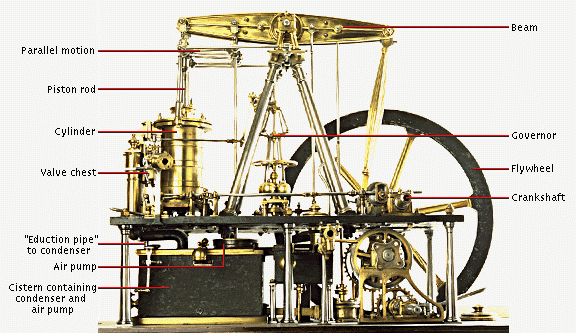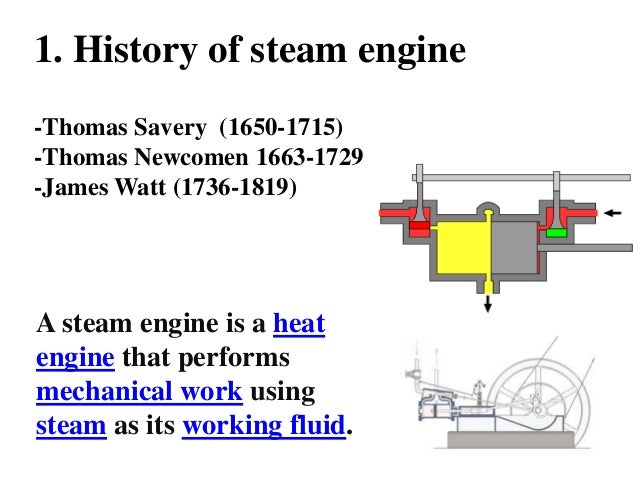 Thomas Savery, an English inventor/engineer, developed a water pimp which utilized steam from a boiler to create its power. The idea itself was brilliant, but Savery could not really make the most out of it, allowing Thomas Newcomen, an English blacksmith to step in and improve things, in 1712.
Thomas Savery, an English inventor/engineer, developed a water pimp which utilized steam from a boiler to create its power. The idea itself was brilliant, but Savery could not really make the most out of it, allowing Thomas Newcomen, an English blacksmith to step in and improve things, in 1712.Newcomen's contraption was most commonly used in coal mines to pump water - where steam was condensed in cylinders creating a fractional vacuum underneath the piston. Air pressure would naturally apply to the top of the piston, forcing it downwards in a regular motion.
James Watt then took over the reins, and the development of the steam engine really began to gather pace. The Scottish engineer noticed from Newcomen's design that a vast amount of heat energy was escaping from the mechanism heating the cylinders. Watt's vision was to use a completely separate condenser, connected to the cylinder via a simple valve, wherein the cylinder would be kept hot, yet the condenser would be kept cold. Watt patented his steam engine in 1769, though it was to be a few years before the engine became available.
As the years progressed, Watt made some alterations to his initial design, including insulation, oil lubrication and a gear system for controlling the motion of the piston. His reformed engine was introduced in 1783.
The steam engine had a dramatic impact all over the world. Setting aside the obvious improvements to transportation speeds, the engine also allowed factories freedom from the reliance on water power. Countries rich in coal began to reap the financial benefits attached - the UK using its own coal reserves to expand the British Empire in both the eighteenth and nineteenth centuries. Trains powered by steam engines proved highly advantageous during the industrialization period.
The steam engine invented by James Watt may, in the current day, look rather basic in comparison to modern day technology, but it was Watt's creation which produced the fundamentals for the engine's development through time.

The first incarnations of the steam engine were wood-powered, before coal was discovered as a superior replacement, allowing the invention of the steam engine to be one of the most pivotal developments in decades. Most valued during the Industrial Revolution, the steam engine offered an increase in transportation speeds, and an obvious positive impact across industrial industries.
It is a well known fallacy that the lead inventor of the steam engine, James Watt, was inspired by watching the power of steam lifting off a kettle lid. In all truth, Watt was truly inspired when working on a Newcomen engine at the University of Glasgow, where he attempted to repair the engine in May, 1765. It's necessary to look at the engine variations leading up to this point, to properly understand the development of the steam engine.
The invention of the engine has played a major role in the environment we live in today - surrounded by transport and industries all reliant on an engine of some description. The engine we see today is a progression of the steam engine, using the same principles, but applied in a more developed manner in the modern world. Every single engine works the same way - a conversion of burning fuel into kinetic energy. It's near enough impossible to imagine a world without the engine, so let's look at the history of the engine and how it has come to the forefront of our industrialized world.
No comments:
Post a Comment